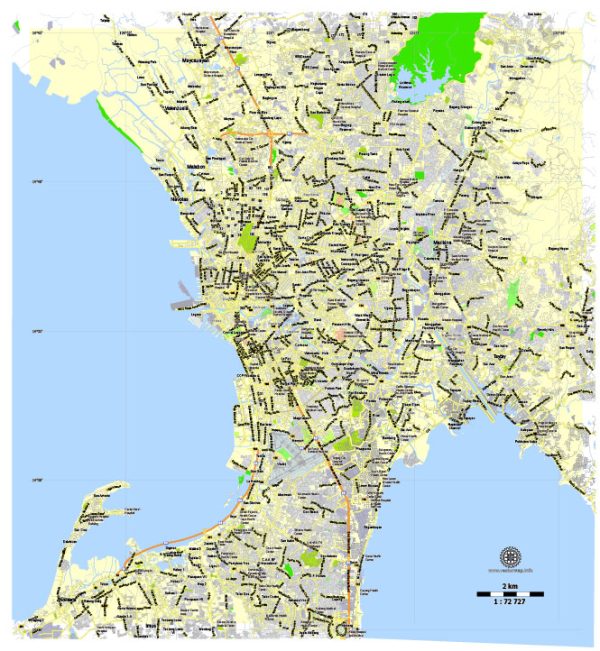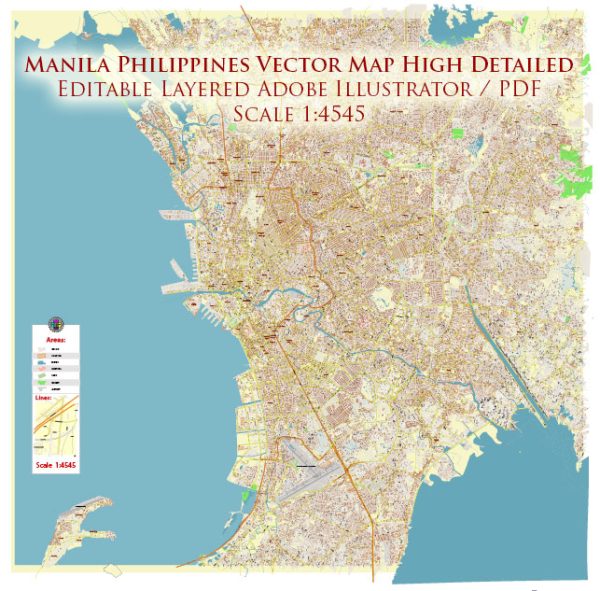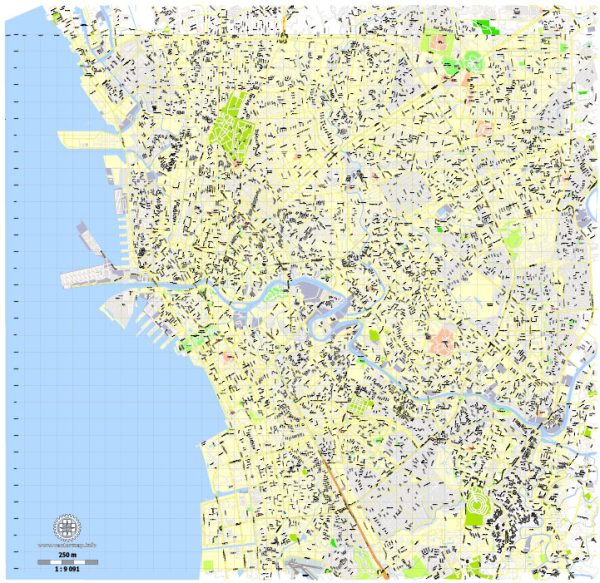Manila is a sprawling metropolis with several districts and neighborhoods, each offering a unique character and atmosphere.
Vectormap.Net provide you with the most accurate and up-to-date vector maps in Adobe Illustrator, PDF and other formats, designed for editing and printing. Please read the vector map descriptions carefully.
Here are some of the notable districts and neighborhoods in Manila, along with brief descriptions of each:
- Intramuros:
- Known as the “Walled City,” Intramuros is the historic heart of Manila. It features well-preserved Spanish colonial architecture, including churches, plazas, and forts. Intramuros offers a glimpse into the city’s colonial past, with sites like Fort Santiago, San Agustin Church, and the Manila Cathedral.
- Ermita:
- Ermita is a district known for its cultural attractions, including the Cultural Center of the Philippines (CCP) complex. This area is home to parks, museums, and entertainment venues. Roxas Boulevard, a scenic coastal road, runs along Ermita, offering views of Manila Bay.
- Malate:
- Adjacent to Ermita, Malate is a lively district known for its nightlife, restaurants, and bars. It has a mix of residential and commercial areas and is popular among both locals and tourists. Malate also hosts the historic Malate Church.
- Makati:
- Makati is the central business district of Manila and the Philippines. It is a major financial and commercial hub with modern skyscrapers, shopping malls, and upscale residential areas. Ayala Avenue is a prominent business and commercial street, while Bonifacio Global City (BGC) is a neighboring business district.
- Quezon City:
- Although technically a separate city, Quezon City is considered part of Metro Manila. It is the most populous city in the Philippines and has a mix of residential, commercial, and government areas. Notable landmarks include the Quezon Memorial Circle and several universities.
- Manila Bay:
- The areas along Manila Bay, including Roxas Boulevard, provide stunning views of the bay’s sunset. This waterfront area has restaurants, parks, and recreational spaces, making it a popular destination for both locals and tourists.
- Binondo:
- Known as the world’s oldest Chinatown, Binondo is a bustling district filled with Chinese-Filipino heritage. It offers a vibrant atmosphere with traditional Chinese shops, markets, and temples. Ongpin Street is a famous food street known for its authentic Chinese cuisine.
- Divisoria:
- Divisoria is a commercial area known for its bustling markets and shopping centers. It is a major wholesale and retail hub where locals and visitors can find a wide range of goods, including textiles, clothing, accessories, and more.
- Paco:
- Paco is a historic district with a mix of residential and commercial areas. It is home to Paco Park, a former cemetery turned park, and the Paco Railway Station, showcasing Spanish colonial architecture.
- San Juan:
- San Juan is a residential area known for its diverse dining scene and shopping options. Greenhills Shopping Center, a popular shopping and entertainment complex, is located here.
These districts and neighborhoods collectively contribute to Manila’s diverse and dynamic urban landscape, offering a wide range of experiences for residents and visitors alike.




 Author: Kirill Shrayber, Ph.D.
Author: Kirill Shrayber, Ph.D.